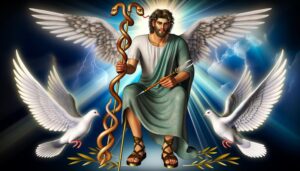Crown Of Thorns Meaning In The Bible: Suffering and Sacrifice
The Crown of Thorns in the Bible holds deep theological significance, encapsulating themes of suffering, mockery, and redemption. It is referenced in the Gospels of Matthew, Mark, and John, where Roman soldiers placed it on Jesus’ head to mock Him as the “King of the Jews.”
Historically, it symbolizes the brutal mockery of condemned criminals, intertwining Jesus’ sacrificial suffering with physical and spiritual anguish.
Theologically, it highlights the paradox of Christ’s kingship—humility and divine sovereignty manifested in suffering. This emblem underscores the cost of grace, inviting more reflection on its profound impact on Christian soteriology and Christology.

Crown of Thorns Meaning in the Bible: Symbolism of Suffering and Kingship
| Aspect | Description |
|---|---|
| Object Description | A woven crown made of thorns placed on Jesus’ head |
| Key Scripture | Matthew 27:29, John 19:2-5 |
| Historical Context | Roman soldiers used it to mock Jesus’ claim of kingship |
| Symbolism | Suffering, mockery, sacrifice, and kingship |
| Spiritual Meaning | Christ’s endurance of pain for humanity’s salvation |
| Fulfillment of Prophecy | Signifies the suffering servant foretold in Isaiah |
| Emotional Impact | Evokes humility, reverence, and gratitude among believers |
| Relevance Today | Reminds Christians of Christ’s love, sacrifice, and triumph over sin |
Historical Context
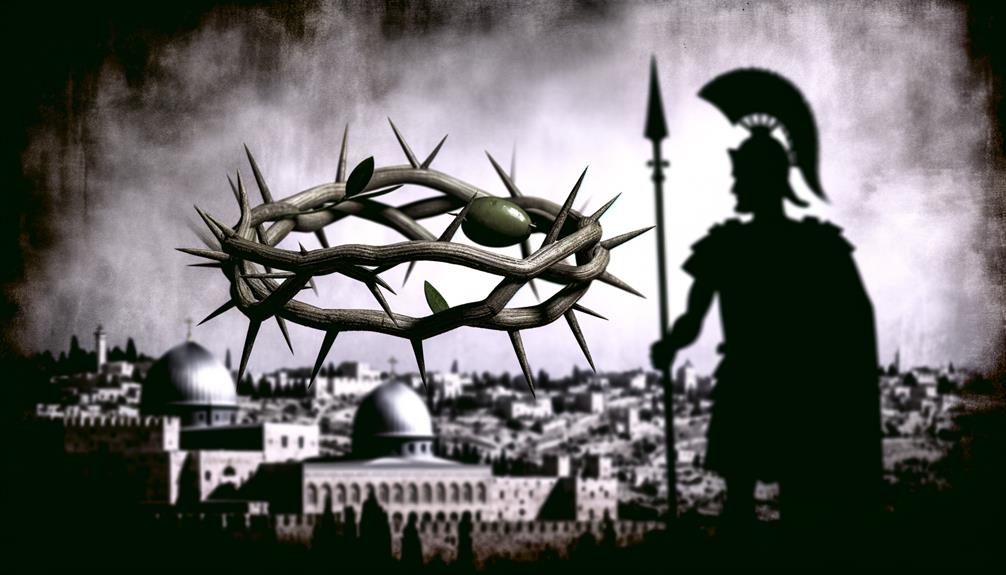
Frequently mentioned in biblical scholarship, the historical context of the Crown of Thorns is vital for understanding its profound theological implications and its symbolic significance within the Christian tradition.
The Crown of Thorns, placed on Jesus’ head during his Passion, serves as a poignant symbol of mockery and suffering. This act is rooted in the Roman practice of mocking condemned criminals, particularly those claiming kingship.
Understanding the socio-political climate of first-century Judea, where Roman authorities employed such brutal methods to assert dominance, is essential. The crown, woven from thorny plants indigenous to the region, symbolizes both the physical torment inflicted upon Jesus and the deeper spiritual anguish.
This historical backdrop enriches the theological reflection on Christ’s sacrificial suffering and redemptive mission.
Biblical References
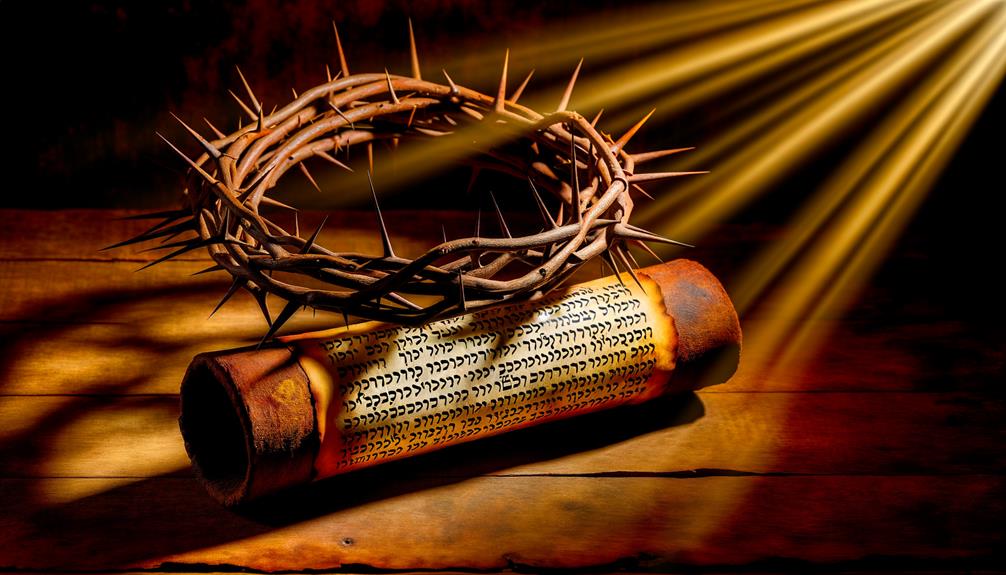
In the New Covenant, the Crown of Thorns is explicitly referenced in the Gospels of Matthew, Mark, and John, each providing unique theological insights into its significance.
In Matthew 27:29, the soldiers mockingly place the crown on Jesus’ head, symbolizing their derision of His claim to kingship.
Mark 15:17 reiterates this act, emphasizing the cruelty and humiliation Jesus endured.
John 19:2-5 provides a detailed description, noting Pilate’s presentation of Jesus to the crowd, highlighting the injustice and suffering.
These passages underscore the Crown of Thorns as a key element in the Passion narrative, illustrating themes of mockery, suffering, and the paradox of Christ’s kingship.
Each account contributes to a thorough theological understanding of this poignant symbol.
Symbolism and Significance
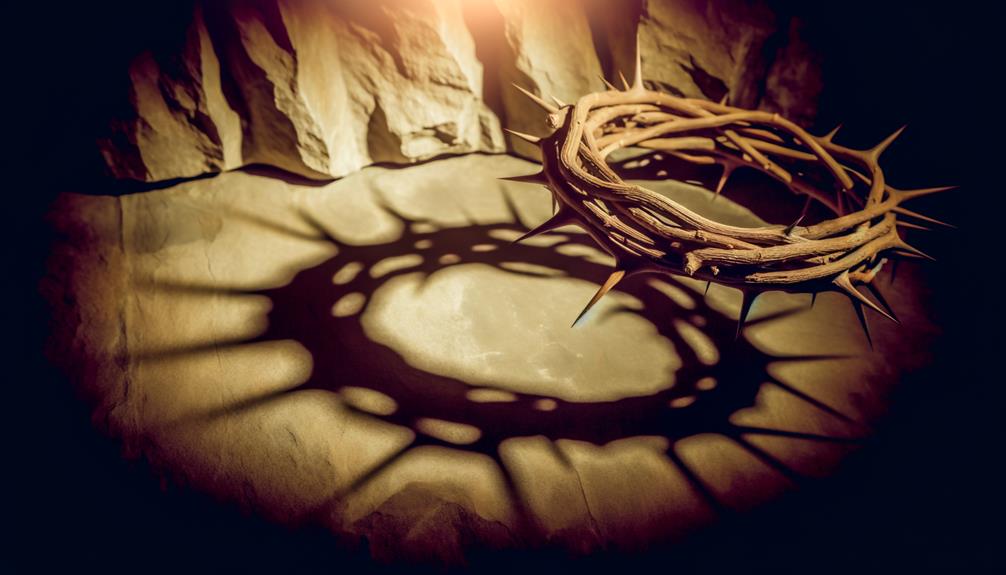
The multifaceted symbolism of the Crown of Thorns extends beyond its immediate context in the Passion narrative, encapsulating profound theological themes of suffering, redemption, and the paradoxical nature of Christ’s kingship.
This emblem, woven from thorns, juxtaposes the pain of human sin with the triumph of divine love. It signifies the mockery Christ endured, yet underscores His ultimate victory over sin and death.
| Symbolism | Significance |
|---|---|
| Suffering | Represents Christ’s physical and emotional pain |
| Redemption | Highlights the sacrificial nature of Christ’s mission |
| Mockery | Emphasizes human scorn and misunderstanding |
| Kingship Paradox | Reflects Christ’s humility and divine sovereignty |
The Crown of Thorns consequently serves as a tangible reminder of the cost of grace and the depth of divine compassion.
Theological Interpretations
From a theological perspective, interpretations of the Crown of Thorns explore its profound implications for understanding Christ’s dual nature as both suffering servant and sovereign king.
The thorns symbolize the curse of sin and humanity’s fall, which Christ bore to redeem mankind. This juxtaposition highlights the paradox of His kingship—marked by humility and sacrificial love.
Theologically, the Crown of Thorns serves as a poignant emblem of atonement, where the physical suffering of Christ underscores His spiritual victory over sin and death.
Additionally, it signifies the inversion of worldly expectations of power and glory, establishing a paradigm wherein true kingship is manifest through self-giving love and redemption. This dual symbolism enriches Christian soteriology and Christology.
Artistic Depictions

Artistic depictions of the Crown of Thorns frequently serve as a powerful visual theology, encapsulating profound spiritual truths and theological concepts.
In Christian art, the Crown of Thorns is often portrayed with meticulous detail, symbolizing Christ’s suffering and the mockery He endured. Renaissance masters like Michelangelo and Titian used this imagery to evoke empathy and piety in viewers.
Theological interpretations are visually communicated through the agony of Christ’s expression, the sharpness of the thorns, and the juxtaposition of divine kingship with abject humiliation.
These artistic renderings not only reflect the Passion narrative but also invite contemplation on themes of sacrifice, redemption, and the paradox of glory through suffering, making them indispensable in Christian iconography.
Modern Reflections
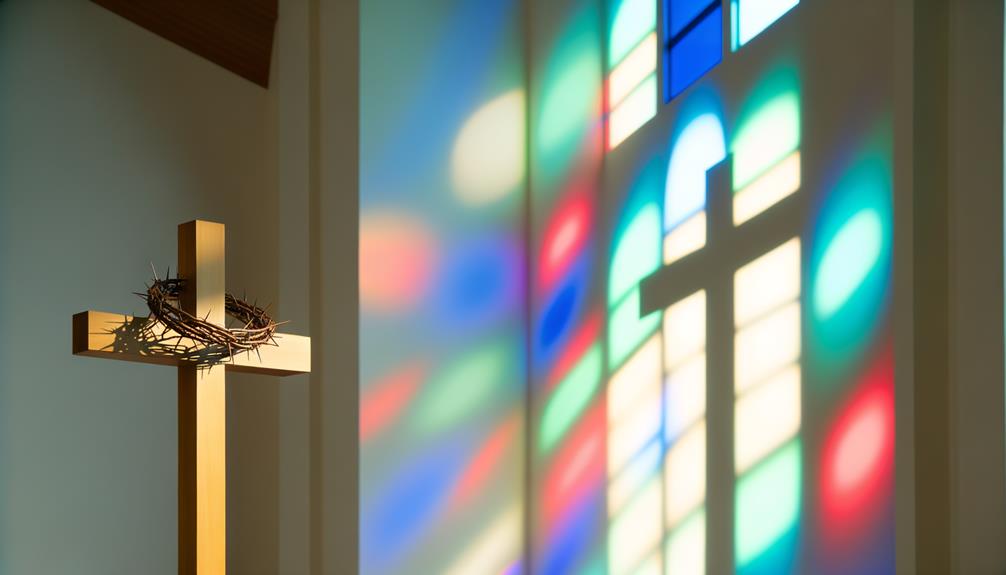
In contemporary theological discourse, the Crown of Thorns continues to be a potent symbol, embodying themes of suffering, redemption, and the paradoxical nature of divine kingship.
This emblem serves as a focal point for understanding the juxtaposition of Christ’s humanity and divinity, reflecting the profound mystery of a sovereign who embraces mortal agony for salvific purposes.
Modern theologians often explore this symbol within the framework of Christological studies, delving into its implications for soteriology and ecclesiology.
Additionally, it invites reflection on the inherent tension between power and vulnerability, prompting believers to reconsider notions of authority and sacrifice.
Consequently, the Crown of Thorns remains a dynamic theological motif, resonating deeply within contemporary Christian thought and practice.
Personal Applications

The Crown of Thorns serves as a profound symbol of sacrifice, calling individuals to embody Christ’s humility in their daily lives and fortify their spiritual resilience.
This theological reflection invites believers to not only recognize the depth of Jesus’ suffering but also to integrate its lessons into personal spiritual practices.
Through embracing these principles, one can cultivate a life marked by selflessness, humility, and unwavering faith.
Symbol of Sacrifice
Numerous biblical scholars contend that the Crown of Thorns serves as a profound symbol of personal sacrifice, reflecting the ultimate act of love and humility demonstrated by Jesus Christ. This emblem of suffering and devotion can inspire believers to contemplate the implications of sacrifice in their own lives.
Practically, the Crown of Thorns urges individuals to:
- Cultivate a deeper sense of empathy towards others.
- Prioritize acts of kindness over personal gain.
- Recognize the value of enduring hardships for a greater cause.
- Embrace a lifestyle of service and selflessness.
This theological perspective invites a rich contemplation on how personal sacrifices, though challenging, can lead to profound spiritual growth and communal harmony.
Embracing Humility Daily
Embracing humility daily requires a conscious and deliberate effort to subordinate one’s own desires and ego for the benefit of others and the greater good. This theological virtue, epitomized by Christ’s acceptance of the Crown of Thorns, challenges believers to reflect on their actions and intentions continually.
In scriptural context, humility is not merely self-effacement but an acknowledgment of one’s limitations and dependence on God. Such a stance fosters community, compassion, and genuine service, aligning personal will with divine purpose.
Practically, it involves acts of kindness, forgiveness, and prioritizing others’ needs.
Spiritual Resilience Inspiration
In times of adversity, spiritual resilience, inspired by the Crown of Thorns, serves as a profound demonstration of unwavering faith and inner strength. This biblical symbol encapsulates the essence of enduring hardship with a fortified spirit.
The Crown of Thorns offers practical applications for personal growth:
- Endurance in Faith: Emulating Christ’s endurance encourages believers to remain steadfast.
- Inner Strength: It symbolizes the cultivation of inner fortitude amidst trials.
- Humility: It teaches the importance of humility in the face of suffering.
- Redemptive Suffering: It highlights the transformative power of suffering when aligned with divine purpose.
These principles foster a resilient spiritual life, grounded in theological depth.
Conclusion
The crown of thorns, deeply entrenched in biblical lore, serves as a poignant emblem of suffering and redemption.
Through historical context, scriptural citations, and theological exegesis, this symbol encapsulates the paradox of ignominy and sanctity.
Artistic renderings and contemporary reflections further amplify its enduring resonance.
Ultimately, the crown of thorns invites contemplation on the intricate interplay between human frailty and divine grace, offering profound insights for both scholarly discourse and personal edification.






